最新24节气英文介绍
- 格式:ppt
- 大小:7.74 MB
- 文档页数:82
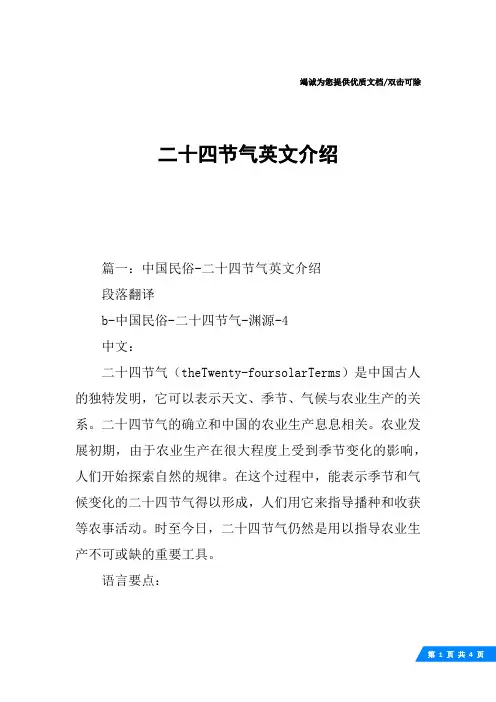
竭诚为您提供优质文档/双击可除二十四节气英文介绍篇一:中国民俗-二十四节气英文介绍段落翻译b-中国民俗-二十四节气-渊源-4中文:二十四节气(theTwenty-foursolarTerms)是中国古人的独特发明,它可以表示天文、季节、气候与农业生产的关系。
二十四节气的确立和中国的农业生产息息相关。
农业发展初期,由于农业生产在很大程度上受到季节变化的影响,人们开始探索自然的规律。
在这个过程中,能表示季节和气候变化的二十四节气得以形成,人们用它来指导播种和收获等农事活动。
时至今日,二十四节气仍然是用以指导农业生产不可或缺的重要工具。
语言要点:establishment;becloselyassociatedwith;attheinitials tageof;behighlysubjectto;comeintobeing;todate;funct ionas;indispensable译文:TheTwenty-foursolarTermsshowtherelationshipbetweent heuniverse,seasons,climateandagriculture,whichisaun iquecreationbychineseancestors.Itsestablishmentwasc loselyassociatedwithchineseagriculturalproduction.A ttheinitialstageofagriculturaldevelopment,peoplebeg antoexplorerulesofnaturesinceagriculturalproduction washighlysubjecttoseasonalchanges.Thus,theTwenty-fo ursolarTermsthatcanindicatethechangesofseasonsandcl imatecameintobeing,andtheywereusedtoguidesowing,har vestingandotheragriculturalactivities.Todate,ithasfunct ionedasanindispensabletooltoguidetheagriculturalpro ductioninchina.篇二:二十四节气的英文表达立春thebeginningofspring(1stsolarterm)雨水Rainwater(2ndsolarterm)惊蛰thewakingofInsects(3rdsolarterm)春分thespringequinox(4thsolarterm)清明purebrightness(5thsolarterm)谷雨grainRain(6thsolarterm)立夏thebeginningofsummer(7thsolarterm)小满grainFull(8thsolarterm)芒种graininear(9thsolarterm)夏至thesummersolstice(10thsolarterm)小暑slightheat(11thsolarterm)大暑greatheat(12thsolarterm)立秋thebeginningofAutumn(13thsolarterm)处暑theLimitofheat(14thsolarterm)白露whiteDew(15thsolarterm)秋分theAutumnalequinox(16thsolarterm)寒露coldDew(17thsolarterm)霜降Frost′sdescent(18thsolarterm)立冬thebeginningofwinter(19thsolarterm)小雪slightsnow(20thsolarterm)大雪greatsnow(21stsolarterm)冬至thewintersolstice(22ndsolarterm)小寒slightcold(23rdsolarterm)大寒greatcold(24thsolarterm)篇三:二十四节气的英文翻译二十四节气的英文表达、英语翻译二十四节气The24solarTerms:立春springbegins雨水Therains惊蛰Insectsawaken春分Vernalequinox清明clearandbright谷雨grainrain立夏summerbegins小满grainbuds芒种graininear夏至summersolstice小暑slightheat大暑greatheat立秋Autumnbegins处暑stoppingtheheat白露whitedews秋分Autumnequinox寒露colddews霜降hoar-frostfalls立冬winterbegins小雪Lightsnow大雪heavysnow冬至wintersolstice小寒slightcold大寒greatcold。
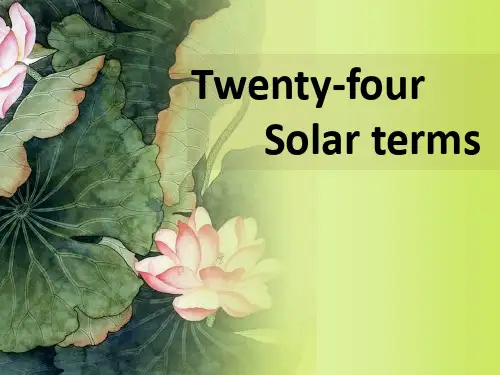
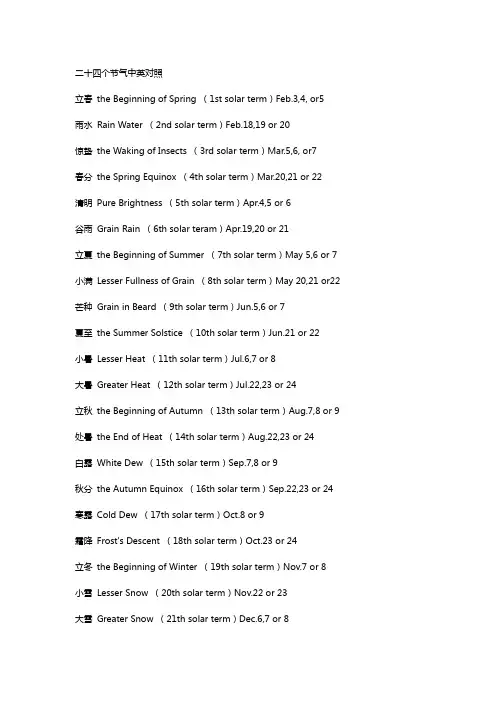
二十四个节气中英对照立春the Beginning of Spring (1st solar term)Feb.3,4, or5雨水Rain Water (2nd solar term)Feb.18,19 or 20惊蛰the Waking of Insects (3rd solar term)Mar.5,6, or7春分the Spring Equinox (4th solar term)Mar.20,21 or 22清明Pure Brightness (5th solar term)Apr.4,5 or 6谷雨Grain Rain (6th solar teram)Apr.19,20 or 21立夏the Beginning of Summer (7th solar term)May 5,6 or 7 小满Lesser Fullness of Grain (8th solar term)May 20,21 or22 芒种Grain in Beard (9th solar term)Jun.5,6 or 7夏至the Summer Solstice (10th solar term)Jun.21 or 22小暑Lesser Heat (11th solar term)Jul.6,7 or 8大暑Greater Heat (12th solar term)Jul.22,23 or 24立秋the Beginning of Autumn (13th solar term)Aug.7,8 or 9 处暑the End of Heat (14th solar term)Aug.22,23 or 24白露White Dew (15th solar term)Sep.7,8 or 9秋分the Autumn Equinox (16th solar term)Sep.22,23 or 24 寒露Cold Dew (17th solar term)Oct.8 or 9霜降Frost's Descent (18th solar term)Oct.23 or 24立冬the Beginning of Winter (19th solar term)Nov.7 or 8小雪Lesser Snow (20th solar term)Nov.22 or 23大雪Greater Snow (21th solar term)Dec.6,7 or 8冬至the Winter Solstice (22th solar term)Dec.21,22 or 23小寒Slight Cold/ Lesser Cold (23th solar term)Jan.5, 6 or 7大寒Great Cold/ Greater Cold (24th solar term)Jan.19, 20 or 21 知识拓展:《二十四节气歌》春雨惊春清谷天,夏满芒夏暑相连。
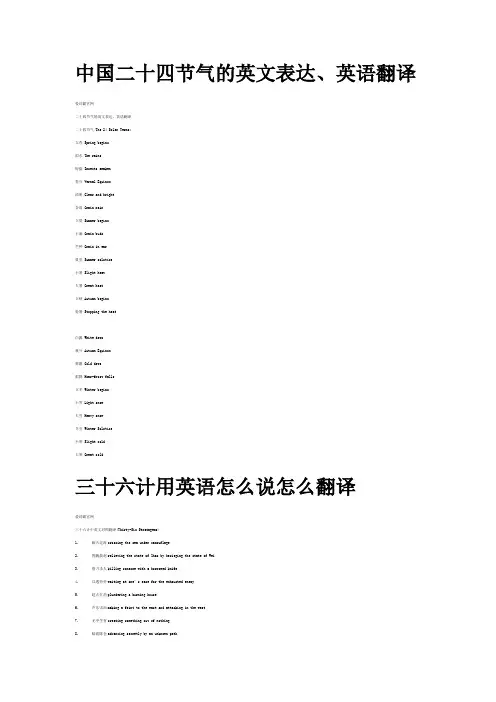
中国二十四节气的英文表达、英语翻译爱词霸官网二十四节气的英文表达、英语翻译二十四节气 The 24 Solar Terms:立春 Spring begins雨水 The rains惊蛰 Insects awaken春分 Vernal Equinox清明 Clear and bright谷雨 Grain rain立夏 Summer begins小满 Grain buds芒种 Grain in ear夏至 Summer solstice小暑 Slight heat大暑 Great heat立秋 Autumn begins处暑 Stopping the heat白露 White dews秋分 Autumn Equinox寒露 Cold dews霜降 Hoar-frost falls立冬 Winter begins小雪 Light snow大雪 Heavy snow冬至 Winter Solstice小寒 Slight cold大寒 Great cold三十六计用英语怎么说怎么翻译爱词霸官网三十六计中英文对照翻译(Thirty-Six Stratagems)1. 瞒天过海crossing the sea under camouflage2. 围魏救赵relieving the state of Zhao by besieging the state of Wei3. 借刀杀人killing someone with a borrowed knife4. 以逸待劳waiting at one’s ease for the exhausted ene my5. 趁火打劫plundering a burning house6. 声东击西making a feint to the east and attacking in the west7. 无中生有creating something out of nothing8. 暗渡陈仓advancing secretly by an unknown path9. 隔岸观火watching a fire from the other side of the river10. 笑里藏刀covering the dagger with a smile11. 李代桃僵palming off substitute for the real thing12. 顺手牵羊picking up something in passing13. 打草惊蛇beating the grass to frighten the snake14. 借尸还魂resurrecting a dead soul by borrowing a corpse15. 调虎离山luring the tiger out of his den16. 欲擒故纵letting the enemy off in order to catch him17. 抛砖引玉giving the enemy something to induce him to lose more valuable things18. 擒贼擒王capturing the ringleader first in order to capture all the followers19. 釜底抽薪extracting the firewood from under the cauldron20. 混水摸鱼muddling the water to catch the fish; fishing in troubled waters21. 金蝉脱壳slipping away by casting off a cloak; getting away like the cicada sloughing its skin22. 关门捉贼catching the thief by closing / blocking his escape route23. 远交近攻befriending the distant enemy while attacking a nearby enemy24. 假途伐虢attacking the enemy by passing through a common neighbor25. 偷梁换柱stealing the beams and pillars and replacing them with rotten timbers26. 指桑骂槐reviling/ abusing the locust tree while pointing to the mulberry27. 假痴不癫feigning madness without becoming insane28. 上屋抽梯removing the ladder after the enemy has climbed up the roof29. 树上开花putting artificial flowers on trees30. 反客为主turning from the guest into the host31. 美人计using seductive women to corrupt the enemy32. 空城计presenting a bold front to conceal unpreparedness33. 反间计sowing discord among the enemy34. 苦肉计deceiving the enemy by torturing one’s own man35. 连环计coordinating one stratagem with another36. 走为上decamping being the best; running away as the best choice。
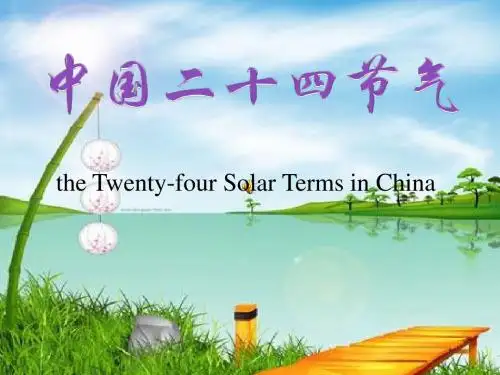
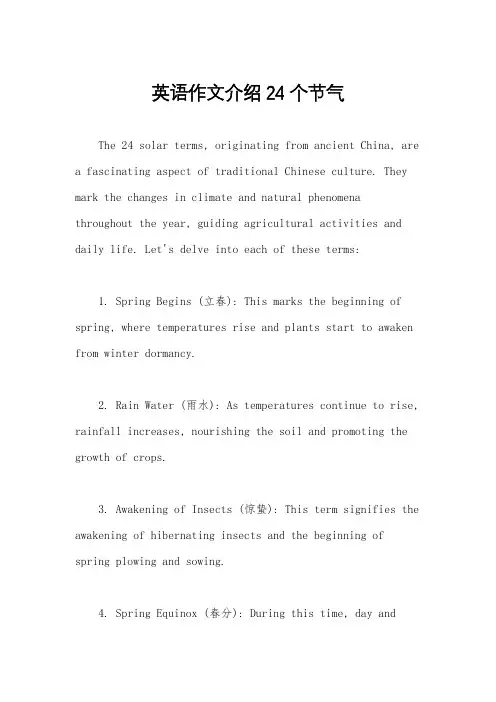
英语作文介绍24个节气The 24 solar terms, originating from ancient China, are a fascinating aspect of traditional Chinese culture. They mark the changes in climate and natural phenomena throughout the year, guiding agricultural activities and daily life. Let's delve into each of these terms:1. Spring Begins (立春): This marks the beginning of spring, where temperatures rise and plants start to awaken from winter dormancy.2. Rain Water (雨水): As temperatures continue to rise, rainfall increases, nourishing the soil and promoting the growth of crops.3. Awakening of Insects (惊蛰): This term signifies the awakening of hibernating insects and the beginning of spring plowing and sowing.4. Spring Equinox (春分): During this time, day andnight are of equal length, symbolizing the balance between light and darkness.5. Clear and Bright (清明): This term marks clearerskies and warmer weather, making it suitable for outdoor activities and tomb-sweeping.6. Grain Rain (谷雨): Rainfall increases further, benefiting the growth of grains and other crops, hence the name "Grain Rain."7. Beginning of Summer (立夏): Summer officially begins, bringing warmer temperatures and lush greenery.8. Grain Full (小满): Crops begin to mature, and fruits start to form, signifying the approaching harvest season.9. Grain in Ear (芒种): This term refers to the period when grains are fully formed and begin to fill their ears, indicating the imminent harvest.10. Summer Solstice (夏至): The longest day of the year,marking the peak of summer and the beginning of shorter days.11. Minor Heat (小暑): Temperatures continue to rise, and the heat becomes more intense, though not yet reaching its peak.12. Major Heat (大暑): The hottest time of the year, with temperatures soaring and heatwaves common across many regions.13. Beginning of Autumn (立秋): Autumn commences, with temperatures gradually cooling down and a noticeable change in the air.14. End of Heat (处暑): This term marks the end of the hottest period, with temperatures starting to decline.15. White Dew (白露): Dew becomes more prominent as temperatures drop, indicating the transition from summer to autumn.16. Autumn Equinox (秋分): Similar to the spring equinox, this term represents the balance between light and darkness, with day and night of equal length.17. Cold Dew (寒露): Temperatures continue to drop, and dew forms as a result of colder nights.18. Frost Descends (霜降): The first frost of the year appears, signaling the imminent arrival of winter.19. Beginning of Winter (立冬): Winter officially begins, with temperatures plummeting and cold winds becoming more prevalent.20. Minor Snow (小雪): The first snowfall of the year, usually light, heralding the arrival of winter.21. Major Snow (大雪): Snowfall becomes heavier andmore frequent, covering the landscape in a blanket of white.22. Winter Solstice (冬至): The shortest day of the year, marking the peak of winter and the beginning oflonger days.23. Minor Cold (小寒): Despite being called "minor," this period brings significant coldness, with temperatures dropping to their lowest of the year.24. Major Cold (大寒): The coldest time of the year, with freezing temperatures and icy conditions prevailing.Each of these solar terms holds cultural significance and reflects the deep connection between nature and human life in traditional Chinese society.。
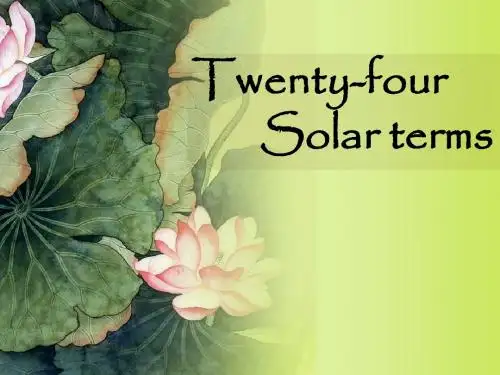
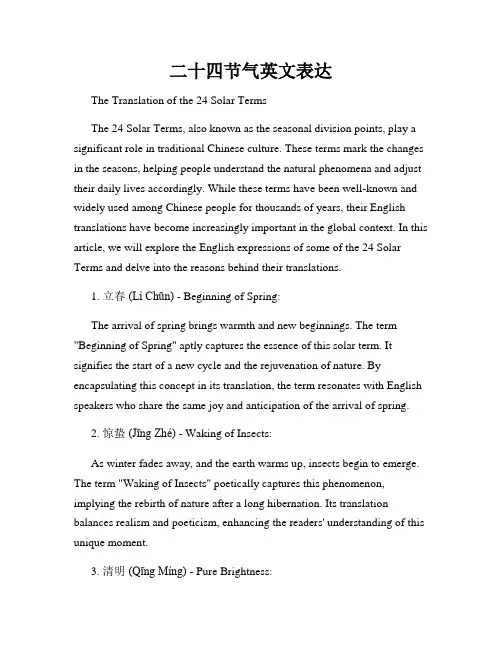
二十四节气英文表达The Translation of the 24 Solar TermsThe 24 Solar Terms, also known as the seasonal division points, play a significant role in traditional Chinese culture. These terms mark the changes in the seasons, helping people understand the natural phenomena and adjust their daily lives accordingly. While these terms have been well-known and widely used among Chinese people for thousands of years, their English translations have become increasingly important in the global context. In this article, we will explore the English expressions of some of the 24 Solar Terms and delve into the reasons behind their translations.1. 立春(Lì Chūn) - Beginning of Spring:The arrival of spring brings warmth and new beginnings. The term "Beginning of Spring" aptly captures the essence of this solar term. It signifies the start of a new cycle and the rejuvenation of nature. By encapsulating this concept in its translation, the term resonates with English speakers who share the same joy and anticipation of the arrival of spring.2. 惊蛰(Jīng Zhé) - Waking of Insects:As winter fades away, and the earth warms up, insects begin to emerge. The term "Waking of Insects" poetically captures this phenomenon, implying the rebirth of nature after a long hibernation. Its translation balances realism and poeticism, enhancing the readers' understanding of this unique moment.3. 清明(Qīng Míng) - Pure Brightness:In early April, the Pure Brightness solar term brings clear skies and bright sunshine. The term "Pure Brightness" reflects the essence of this period when nature is at its freshest, and everything appears clear and bright. Its translation conveys the visual imagery associated with this term, immersing the readers in the sense of tranquility and serenity that accompanies this season.4. 立夏 (Lì Xià) - Beginning of Summer:With summer approaching, the term "Beginning of Summer" precisely captures the transition from spring to summer. It symbolizes the onset of warmer weather, longer days, and a shift in daily routines. The translation resonates with English speakers who associate this time of the year with outdoor activities, celebrations, and vacations.5. 小满(Xiǎo Mǎn) - Grain Buds:During this period, crops begin to mature, and small grains appear on plants. The term "Grain Buds" effectively conveys the visual image of plants budding and crops thriving. The translation paints a vivid picture of fields filled with promise and abundance, enabling English readers to appreciate the importance of this seasonal milestone.6. 夏至 (Xià Zhì) - Summer Solstice:As the longest day of the year, the Summer Solstice brings heat and energy to the world. The term "Summer Solstice" encapsulates the astronomical significance of this solar term, making it universally understood across cultures and languages. Its translation allows Englishspeakers to relate to this exceptional day when the sun reaches its highest point in the sky.In conclusion, the translation of the 24 Solar Terms into English requires a careful consideration of cultural and natural elements. By capturing the essence of each term in its translation, we can bridge the gap between different languages and cultures, allowing people worldwide to appreciate and understand the beauty and significance of these seasonal milestones.。
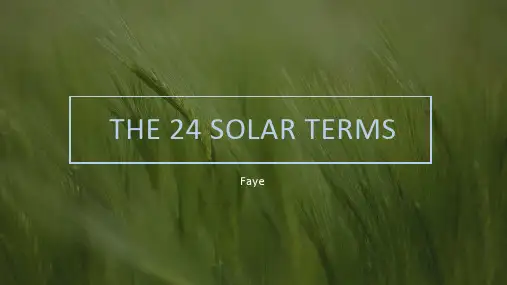
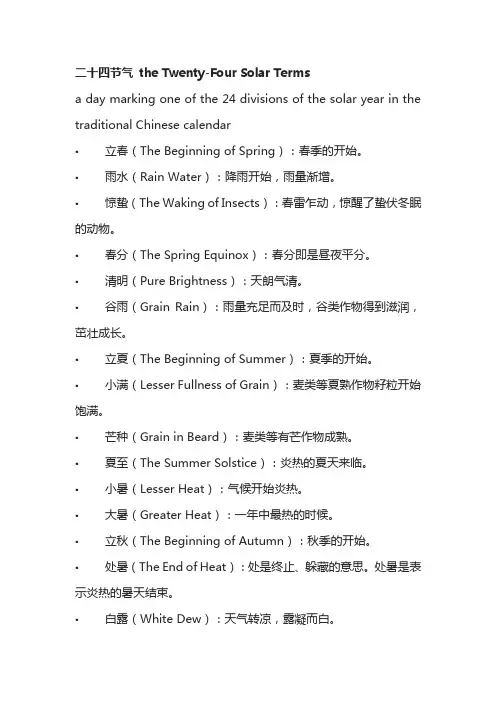
二十四节气the Twenty-Four Solar Termsa day marking one of the 24 divisions of the solar year in the traditional Chinese calendar▪立春(The Beginning of Spring):春季的开始。
▪雨水(Rain Water):降雨开始,雨量渐增。
▪惊蛰(The Waking of Insects):春雷乍动,惊醒了蛰伏冬眠的动物。
▪春分(The Spring Equinox):春分即是昼夜平分。
▪清明(Pure Brightness):天朗气清。
▪谷雨(Grain Rain):雨量充足而及时,谷类作物得到滋润,茁壮成长。
▪立夏(The Beginning of Summer):夏季的开始。
▪小满(Lesser Fullness of Grain):麦类等夏熟作物籽粒开始饱满。
▪芒种(Grain in Beard):麦类等有芒作物成熟。
▪夏至(The Summer Solstice):炎热的夏天来临。
▪小暑(Lesser Heat):气候开始炎热。
▪大暑(Greater Heat):一年中最热的时候。
▪立秋(The Beginning of Autumn):秋季的开始。
▪处暑(The End of Heat):处是终止、躲藏的意思。
处暑是表示炎热的暑天结束。
▪白露(White Dew):天气转凉,露凝而白。
▪秋分(The Autumn Equinox):昼夜平分。
▪寒露(Cold Dew):露水以寒,将要结冰。
▪霜降(Frost's Descent):持续降温,开始有霜。
▪立冬(The Beginning of Winter):冬季的开始。
▪小雪(Lesser Snow):开始下雪。
▪大雪(Greater Snow):降雪量增多,地面可能积雪。
▪冬至(The Winter Solstice):寒冷的冬天来临。
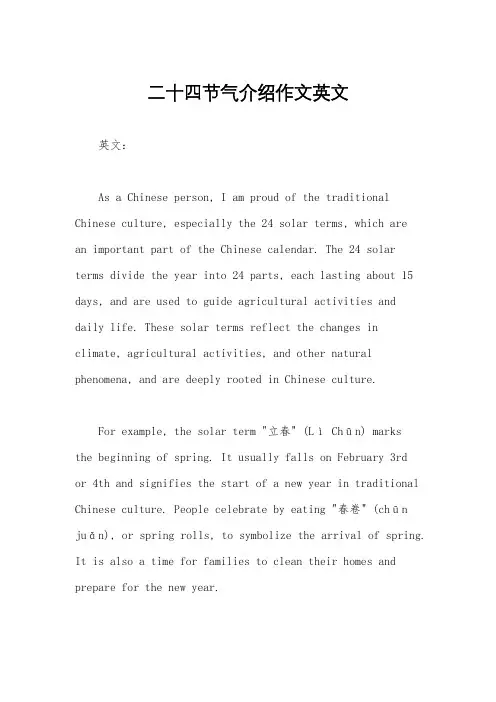
二十四节气介绍作文英文英文:As a Chinese person, I am proud of the traditional Chinese culture, especially the 24 solar terms, which arean important part of the Chinese calendar. The 24 solar terms divide the year into 24 parts, each lasting about 15 days, and are used to guide agricultural activities anddaily life. These solar terms reflect the changes in climate, agricultural activities, and other natural phenomena, and are deeply rooted in Chinese culture.For example, the solar term "立春" (Lì Chūn) marksthe beginning of spring. It usually falls on February 3rdor 4th and signifies the start of a new year in traditional Chinese culture. People celebrate by eating "春卷" (chūnjuǎn), or spring rolls, to symbolize the arrival of spring. It is also a time for families to clean their homes and prepare for the new year.Another solar term, "小满" (Xiǎo Mǎn), which means "grain buds" in English, marks the time when the seeds of summer crops begin to swell. It is a crucial time for farmers to plant their crops and ensure a good harvest. In modern times, people may take this opportunity to go on a picnic and enjoy the beautiful weather.These examples illustrate how the 24 solar terms are not only a reflection of the changes in nature but also an integral part of Chinese culture and traditions. They provide a unique insight into the Chinese way of life and the connection between humans and the natural world.中文:作为中国人,我为传统的中国文化感到自豪,尤其是24节气,它是中国历法的重要组成部分。
24节气英语介绍短文Introducing the 24 Solar Terms in EnglishThe 24 solar terms, also known as the 24 seasonal divisions, are a traditional Chinese calendar system that divides the year into 24 periods based on the sun's position in the zodiac. This ancient system has been used in China for centuries and has influenced the agricultural practices and cultural traditions of the country. As we explore the 24 solar terms, we will gain a deeper understanding of the rich heritage and seasonal rhythms that have shaped the lives of the Chinese people.The first solar term is known as Lichun, which marks the beginning of spring. This term occurs around the 4th or 5th of February and signifies the end of the winter chill and the awakening of nature. During this time, farmers begin to prepare their fields for planting, and many cultures celebrate the arrival of a new year with festivals and rituals.Following Lichun is Yushui, the Rain Water term, which typically falls around the 19th of February. This period is characterized by increased rainfall and the gradual melting of snow, signaling thetransition from winter to spring. Farmers may take advantage of the wet conditions to begin their planting and irrigate their fields.The next solar term is Jingzhe, or Waking of Insects, which occurs around the 5th or 6th of March. This term marks the time when hibernating insects begin to emerge from their winter slumber, signaling the start of a new cycle of growth and renewal. Many birds and other animals also become more active during this period, heralding the arrival of spring.Chunfen, or the Spring Equinox, falls around the 20th of March. This term represents the time when the day and night are of equal length, and the sun's rays shine directly on the equator. This is a significant time in Chinese culture, as it is often celebrated with traditional festivals and rituals that honor the balance and harmony of the natural world.Qingming, also known as Tomb Sweeping Day, typically falls around the 4th or 5th of April. This term is associated with the ancestral veneration rituals that take place during this time, where families visit the graves of their deceased loved ones and make offerings to honor their memory.The next solar term is Guyu, or Grain Rain, which occurs around the 20th of April. This period is marked by increased rainfall and thecontinued growth of crops and vegetation. Farmers may need to adjust their planting and irrigation practices to ensure the healthy development of their crops.Lixia, or the Beginning of Summer, falls around the 5th or 6th of May. This term signifies the transition from spring to summer, with warmer temperatures and the blooming of flowers and trees. Many cultural festivals and celebrations take place during this time, as people embrace the vibrant energy of the summer season.Xiaoman, or Grain in Ear, typically falls around the 21st of May. This term is associated with the ripening of grains and the preparations for the upcoming harvest season. Farmers may need to monitor their crops closely and take steps to protect them from pests and adverse weather conditions.Mangzhong, or Grain Buds, occurs around the 6th or 7th of June. This term marks the time when the grains have developed their first buds, signaling the continued progress towards the harvest. Farmers may need to adjust their irrigation and fertilization practices to ensure the healthy growth of their crops.Xiazhi, or the Summer Solstice, falls around the 21st or 22nd of June. This term represents the longest day of the year and the beginning of the summer season. Many cultures around the world celebratethis time with festivals and rituals that honor the sun and the natural world.Xiao Shu, or Lesser Heat, typically falls around the 7th or 8th of July. This term signifies the continued rise in temperatures and the peak of the summer season. During this time, people may need to take measures to stay cool and hydrated, such as seeking shade, drinking plenty of water, and engaging in activities that help them adapt to the hot weather.Da Shu, or Greater Heat, occurs around the 23rd of July. This term represents the hottest part of the summer, with temperatures often reaching their highest levels. Farmers may need to adjust their irrigation and pest management practices to ensure the survival of their crops during this challenging period.Liqiu, or the Beginning of Autumn, falls around the 8th or 9th of August. This term marks the transition from summer to autumn, with cooler temperatures and the gradual changing of the leaves on the trees. Many cultural festivals and traditions are associated with this time of year, as people celebrate the beauty and abundance of the autumn season.Chu Shu, or Limit of Heat, typically falls around the 23rd of August. This term signifies the gradual cooling of temperatures and the startof the autumn season. Farmers may begin to prepare for the upcoming harvest, while people may start to adjust their clothing and activities to match the changing weather conditions.Bailu, or White Dew, occurs around the 8th or 9th of September. This term is associated with the appearance of dew on the grass and plants, signaling the continued cooling of the air and the approach of the autumn season. During this time, people may engage in activities such as collecting medicinal herbs and enjoying the natural beauty of the landscape.Qiu Fen, or the Autumn Equinox, falls around the 23rd of September. This term represents the time when the day and night are of equal length, and the sun's rays shine directly on the equator. This is a significant time in Chinese culture, as it is often celebrated with traditional festivals and rituals that honor the balance and harmony of the natural world.Han Lu, or Cold Dew, typically falls around the 8th or 9th of October. This term is associated with the increasing presence of dew and the gradual drop in temperatures, signaling the approach of the winter season. During this time, people may need to adjust their clothing and activities to stay warm and comfortable.Shuang Jiang, or Frost's Descent, occurs around the 23rd of October.This term marks the time when the first signs of frost begin to appear, signaling the continued cooling of the air and the transition to the winter season. Farmers may need to take steps to protect their crops and livestock from the colder weather.Lidong, or the Beginning of Winter, falls around the 7th or 8th of November. This term represents the official start of the winter season, with cooler temperatures and the potential for snowfall. During this time, people may engage in activities such as preparing for the winter months, gathering firewood, and enjoying indoor activities to stay warm and cozy.Xiaoxue, or Lesser Snow, typically falls around the 22nd or 23rd of November. This term is associated with the first significant snowfall of the season, signaling the continued progression of the winter season. Farmers may need to take steps to protect their livestock and crops from the harsh winter conditions.Da Xue, or Greater Snow, occurs around the 7th or 8th of December. This term represents the heaviest snowfall of the winter, with the potential for significant accumulation. During this time, people may need to adjust their daily routines and activities to accommodate the colder weather and the increased snowfall.Dongzhi, or the Winter Solstice, falls around the 21st or 22nd ofDecember. This term marks the shortest day of the year and the official start of the winter season. Many cultures around the world celebrate this time with festivals and rituals that honor the sun and the natural world.Xiao Han, or Lesser Cold, typically falls around the 5th or 6th of January. This term signifies the continued cooling of temperatures and the approach of the coldest part of the winter season. During this time, people may need to take steps to stay warm and protect themselves from the harsh weather conditions.Da Han, or Greater Cold, occurs around the 20th or 21st of January. This term represents the peak of the winter season, with the lowest temperatures and the potential for severe weather conditions. Farmers may need to take steps to protect their livestock and crops from the extreme cold, while people may engage in activities that help them stay warm and cozy.The 24 solar terms provide a rich and nuanced understanding of the seasonal changes that occur throughout the year. By exploring these terms, we can gain a deeper appreciation for the intricate balance and rhythms of the natural world, and the ways in which traditional Chinese culture has adapted to and celebrated these seasonal shifts. Whether you are a farmer, a nature enthusiast, or simply someone who is curious about the cultural heritage of China, the 24 solarterms offer a fascinating and insightful window into the timeless patterns of the seasons.。
英文24节气介绍二十四节气是古代中国的时间计算系统,用来描述一年中的气候变化和农事活动。
以下是英文介绍二十四节气的简要内容:The 24 Solar Terms, also known as the 24 Chinese Seasonal Points, are a traditional Chinese calendar system that divides the year into 24 segments based on the sun's position in the ecliptic. Each solar term marks a turning point in the seasons and is associated with specific agricultural activities and natural phenomena. The 24 solar terms are used to guide farming practices, traditional Chinese medicine, and cultural festivals.The 24 solar terms are divided into 12 major solar terms and 12 minor solar terms. The major solar terms include the Beginning of Spring, Rain Water, Awakening of Insects, Clear and Bright, Grain Rain, Summer Solstice, Slight Heat, Great Heat, Beginning of Autumn, White Dew, Winter Solstice, and Slight Cold. The minor solar terms are used to further divide the major solar terms into smaller time periods.The 24 Solar Terms reflect the ancient Chinese wisdom of living in harmony with nature and observing seasonal changes to guide daily life and agricultural practices. Today, the 24 Solar Terms continue to be celebrated in China and other East Asian countries as important cultural and traditional festivals.。